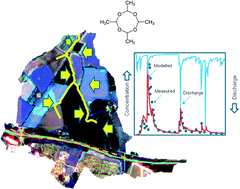A new conceptual model of pesticide transfers from agricultural land to surface waters with a specific focus on metaldehyde†
Abstract
Pesticide losses from agricultural land to water can result in the environmental deterioration of receiving systems. Mathematical models can make important contributions to risk assessments and catchment management. However, some mechanistic models have high parameter requirements which can make them difficult to apply in data poor areas. In addition, uncertainties in pesticide properties and applications are difficult to account for using models with long run-times. Alternative, simpler, conceptual models are easier to apply and can still be used as a framework for process interpretation. Here, we present a new conceptual model of pesticide behaviour in surface water catchments, based on continuous water balance calculations. Pesticide losses to surface waters are calculated based on the displacement of a limited fraction of the soil pore water during storm events occurring after application. The model was used to describe the behaviour of metaldehyde in a small (2.2 km2) under-drained catchment in Eastern England. Metaldehyde is a molluscicide which has been regularly detected at high concentrations in many drinking water supply catchments. Measured peak concentrations in stream water (to about 9 μg L−1) occurred in the first few storm events after application in mid-August. In each event, there was a quasi-exponential decrease in concentration during hydrograph recession. Peak concentrations decreased in successive events – responding to rainfall but reflecting an effective exhaustion in soil supply due to degradation and dissipation. Uncertain pesticide applications to the catchment were estimated using land cover analysis of satellite data, combined with a Poisson distribution to describe the timing of application. Model performance for both the hydrograph (after calibration of the water balance) and the chemograph was good and could be improved via some minor adjustments in assumptions which yield general insights into the drivers for pesticide transport. The use of remote sensing offers some promising opportunities for estimating catchment-scale pesticide applications and associated losses.



 Please wait while we load your content...
Please wait while we load your content...